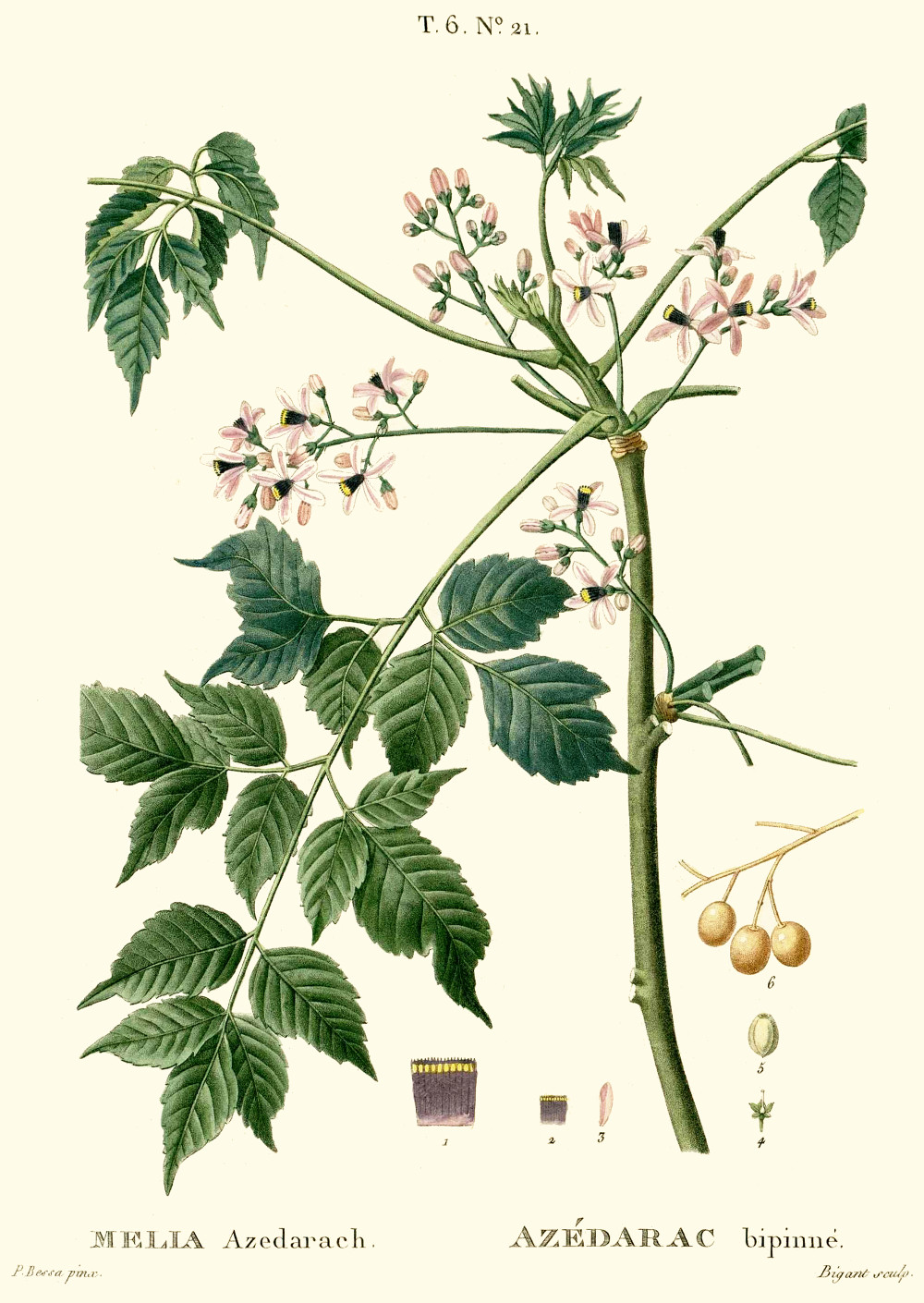Melia azedarach L. - syn. Melia candollei A. Juss.; Melia floribunda Carrière; Melia toosendan Siebold & Zucc. - Meliaceae
China berry, Chinaberry, bead tree, Persian lilac, Pride of India, Indischer Zedrachbaum, Indischer Flieder, Persischer Flieder, Paradiesbaum, Perlen- oder Paternosterbaum, Stolz von Indien
Deciduous tree, native to China, Himalaya, Persia; flowers lilac, fragrant; fruit yellow.
„The hard, five-grooved seeds were widely used for making rosaries and other products requiring beads; however, the seeds were later replaced by plastics… Fruits are poisonous to humans if eaten in quantity… The toxins are neurotoxins and unidentified resins, found mainly in the fruits… Like in relatives, tetranortriterpenoids constitute an important toxic principle. These are chemically related to azadirachtin, the primary insecticidal compound in the commercially important neem oil.“ https://en.wikipedia.org/wiki/Melia_azedarach
The meliacarpin derivatives 1,3-dicinnamoyl-11-hydroxymeliacarpin, 1-cinnamoyl-3-methacrylyl-11-hydroxymeliacarpin and 1-cinnamoyl-3-acetyl-11-hydroxymeliacarpin, were isolated as the principal insecticidal and growth disrupting constituents of Melia azedarach leaves. „The insecticidal properties of the new meliacarpin derivatives were examined using larvae of the polyphagous pest insect Spodoptera littoralis. When incorporated into artificial diet and offered to larvae in a chronic feeding bioassay, 1-cinnamoyl-3-acetyl-11-hydroxymeliacarpin exhibited an EC50 of 0.27 ppm and a LC50 of 0.48 ppm and is thus comparable with regard to insecticidal activity to the well known natural insecticide azadirachtin. Furthermore, all three meliacarpin derivatives had a pronounced detrimental influence on larval metamorphosis.“
[Insecticidal meliacarpins (C-seco limonoids) from Melia azedarach., Bohnenstengel, F.I., Wray, V., Witte, L., Srivastava, R.P., Proksch, P., Phytochemistry, 50(6), 1999, 977-982]
„Fruit extracts of M. azedarach have long been known to have insecticidal activities, in some cases comparable to that of neem. Like M. volkensii, M. azedarach lacks azadirachtins, but fruits produce the chemically related meliacarpins that have azadirachtin-like bioactivity in many types of insect.“
[Isman, M. B. (2005). Chapter Six-Tropical Forests as Sources of Natural Insecticides. Recent Advances in Phytochemistry, 39, 145-161]
„A formulation made with both extract and oil [obtained from fruits of Melia azedarach L.] at 10% plus the addition of emulsifier and preserving agents showed 92.3% pediculicidal activity. The products were also successful in delaying or inhibiting nymph emergence, with the formulation being the most effective, with a complete inhibition of emergence.“
[In vitro pediculicidal and ovicidal activity of an extract and oil from fruits of Melia azedarach L., Carpinella, M.C., Miranda, M., Almirón, W.R., Ferrayoli, C.G., Almeida, F.L., Palacios, S.M., Journal of the American Academy of Dermatology, 56(2), 2007, 250-256]
„In traditional Chinese medicine, Melia azedarach (Ku-lian) is used orally and topically as an antiparasitic and antifungal agent. Although toxicity of this plant has been widely described in veterinary literature, human poisoning is rarely reported… human M. azedarach poisoning is said to occur if six to nine fruits, 30 to 40 seeds, or 400 g of the bark is consumed. Onset of symptoms typically occurs within 4-6 h, but as short as 0.5 h had been documented.“
[Human Melia azedarach poisoning., Phua, D.H., Tsai, W.J., Ger, J., Deng, J.F., Yang, C.C., Clinical Toxicology, 46(10), 2008, 1067-1070]

Duhamel du Monceau,H.L., Traité des arbres et arbustes, Nouvelle édition [Nouveau Duhamel], vol.6, t.21 (1815) [P.Bessa]
http://plantgenera.org/species.php?id_species=654066